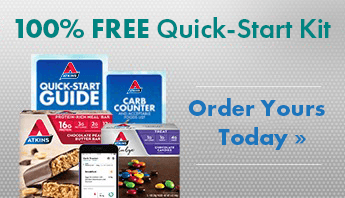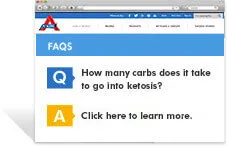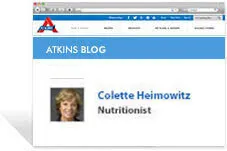How it works Atkins 20 Phase 2
Atkins 20
Phase Two Overview: Balancing Your Diet
PHASE TWO TIPS FOR MAINTAINING WEIGHT LOSS
PHASE TWO LOW CARB FOOD LIST
PHASE TWO FACTS ABOUT EFFECTIVE WEIGHT LOSS PLANS
PHASE TWO SUSTAINABLE WEIGHT LOSS STRATEGIES
This balancing phase is designed to help your body lose excess weight after the more rapid progress of Phase 1. While your list of acceptable foods will grow, the goal is to continue your weight loss in a way that will be more sustainable.
See details below on Phase 2 and how to balance your low carb diet.
Typically until you’re within 10 pounds of your goal weight, although you can transition to Phase 3 sooner if you’re willing to slow the pace of weight loss.
Lose most of your excess pounds and find your personal carb balance.
Starting at 25 grams of Net Carbs daily, begin to increase overall carb intake in 5-gram increments. This means gradually reintroducing a broader array of carb foods as you step up the Carb Ladder, finding your personal carb balance. It could level off anywhere between 30 and 80 daily grams of Net Carbs or even higher. Your personal number is impacted by your age, gender, activity level, hormonal status, and other factors as you continue to lose weight.
- Continue to consume a minimum of 12–15 daily grams of Net Carbs as foundation vegetables. Also continue to avoid foods with added sugar, have eight glasses of water or other acceptable fluids each day, and go no longer than three or four hours between meals or snacks, spreading out your carb intake across the day.
- Reintroduce food groups one by one, following the Carb Ladder. Depending on your metabolism and weight-loss goal, this may be at weekly intervals, every couple of weeks, or even longer.Click here for more information about the carb ladder.
- Add back carb foods within each rung of the ladder one by one as well. For example, reintroduce walnuts but gauge their impact, if any, before reintroducing almonds.
- Increase your overall daily Net Carb intake in 5-gram increments at weekly, biweekly, or even monthly intervals, whichever works best for you.
- Continue to weigh and measure yourself weekly.
Here’s how to succeed on Phase 2 as you proceed up the Carb Ladder.
Welcome to freedom, variety and finding your personal carb balance. Combine this list with all the options from Phase I and you’ve got a broader selection of foods to choose from. So enjoy, keep your eye on the end goal and welcome to Phase 2.
During Phase 2, you add higher carb foods back into your diet – 5 daily Net Carbs per week. You can move beyond vegetables to other foods, such as nuts, seeds and berries. Although you will be eating primarily natural, unprocessed foods, you will find an increasing number of convenience foods – choices that help even busy people stay on track during weight loss.
Net Carbs
New Serving Size
3
5 ounces
Mozzarella cheese
3.5
1/2 cup or 4 ounces
Yogurt, Greek, Plain, unsweetened, whole milk
3.8
1/2 cup
Ricotta cheese
4.1
1/2 cup
Cottage cheese 2%
4.8
3/4 cup
Heavy cream
5.5
1/2 cup or 4 ounces
Yogurt, Plain, Unsweetened, whole milk
Net Carbs
New Serving Size
1.4
6 nuts
Brazil nuts
1.4
10 nuts
Macadamias
1.5
2 TBSP
Hulled sunflower seeds
1.7
12 nuts
Walnuts
2.2
24 nuts
Almonds
3
2 TBSP
Pistachios
3.8
2 TBSP
Peanuts
3.8
2 TBSP
Pecans
5.1
2 TBSP
Cashews
Net Carbs
New Serving Size
1.6
1/4 cup
Blackberries (fresh)
1.7
1/4 cup
Raspberries (fresh)
1.9
1/4 cup
Cranberries (fresh)
2.4
1/4 cup
Strawberries, sliced (fresh)
2.9
1/4 cup
Cantaloupe, cubes
3.5
1/4 cup
Honeydew, cubes
3.9
1/4 cup
Gooseberries (fresh)
4.5
1/4 cup
Boysenberries (fresh)
4.5
1/4 cup
Blueberries (fresh)
Net Carbs
New Serving Size
2
2 TBSP
Lemon juice
2.4
2 TBSP
Lime juice
4
4 ounces
Tomato juice
Net Carbs
New Serving Size
4
1/4 cup
Lentils
5.9
1/4 cup
Kidney Beans
6.1
1/4 cup
Lima Beans
6.1
1/4 cup
Pinto Beans
6.5
1/4 cup
Black Beans
10.1
1/4 cup
Navy Beans
10.6
1/4 cup
Great Northern Beans
10.9
1/4 cup
Chickpeas
Here are some FAQs that you may encounter during Phase 2:
First of all, don’t beat yourself up. We all have moments of weakness, and maybe that plate of French fries your friend was eating was more than you could resist. Second, don’t play the game of “Well, since I’ve already messed up, I might as well go whole hog.” For the rest of the day eat appropriately. Don’t wait until tomorrow to get back on the wagon.
Without realizing it, as you gradually add back foods, you may be consuming far more carbs than you think you are. This can make you complacent about your intake until your weight loss stalls. Once again, tracking your carbs and portion sizes should help you avoid carb creep.
Usually cravings vanish by the end of the first week on Phase 1/Induction when you convert to burning primarily fat for energy. There are several reasons they may return. Women sometimes experience cravings a few days before their menstrual period. Going too long between meals or adding foods such as dairy products or peanuts may stimulate cravings. Stress can also destabilize blood sugar, triggering cravings for comfort foods. Adding a bit more fat, in the form of olives, half an avocado, or some cream cheese in a celery stick, can help you feel more satisfied, minimizing cravings.
Of course not. If you don’t like yogurt or chickpeas or tomato juice, so be it. Or if a whole rung on the Carb Ladder holds no appeal for you, just skip it. There’s still plenty of variety inherent in the whole foods you can eat on Atkins.
As discussed in regard to plateaus, your body has its own schedule and won’t share it with anyone. The important thing is to follow the program faithfully and the pounds will come off. Again, adding exercise helps some people lose weight, but not everyone. Be sure to take your measurements weekly. If you’ve lost inches, the scale is bound to catch up.
The reason we recommend that you not weigh yourself daily is that your weight can vary by as much as 5 pounds even within a day. As long as you’re following the program, you should see some weight loss every week or so, unless you’re on a plateau. If you stayed on track but gained a pound or two since the previous week, you’re probably retaining water or are constipated.
- You’ve reached a daily intake of about 50 grams of Net Carbs, have introduced Phase 2 foods, and continue to slim down without experiencing cravings and unreasonable hunger. If so, feel free to transition to Phase 3 now if you’re eager for more variety in your meals. If you stall out there, you can always return to Phase 2 to reboot weight loss.
- You still have more than 10 pounds to shed and are stalled in your weight-loss progress and/or experiencing cravings and extreme hunger before meals. By all means, stay in this phase until the cravings and hunger have vanished.
- Although you lost weight in Phase 1, your progress in this phase has been frustrating, and some Phase 2 foods are creating cravings and undue hunger. You may have even gained a few pounds. You may be extraordinarily sensitive to carbs and may have reached your carb tolerance at 30 or 35 grams of Net Carbs. Follow the advice above, be patient, and ramp up your activity level if possible.
If you’ve lost weight steadily and are now only about 10 pounds from your goal weight, it’s time to move on to Phase 3, because your long-term goal is to find a sustainable way of eating. And with 10 pounds to go, you have enough time to try to reintroduce the remaining carb foods.
If you aren’t yet 10 pounds from your goal, ask yourself which of these three scenarios describes you:
Atkins Newsletter
Thank you for your submission! You have been added to our list!


FAQ
Get answers to the most frequently asked questions about the Atkins Diet and the Atkins principles

Science/Library
Read nutrition articles, learn the science behind Atkins, and sample the extensive amount of peer-reviewed published studies in major scientific journals demonstrating the effectiveness and the health benefits of the Atkins diet.


Free Weight Loss Tools
All the Atkins tools you need to succeed on the program, and they’re all 100% free!